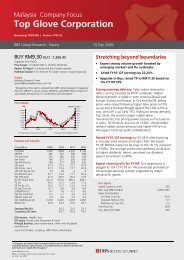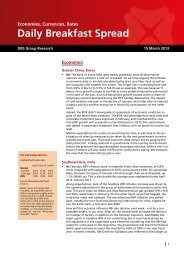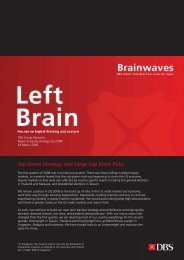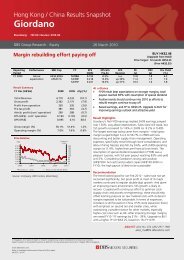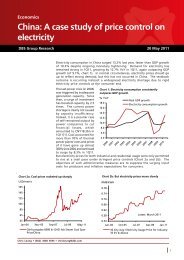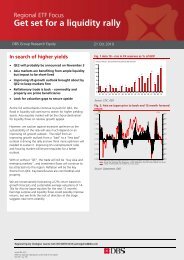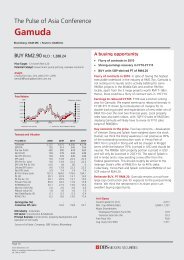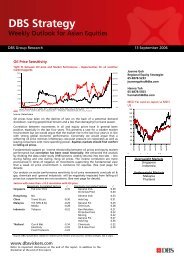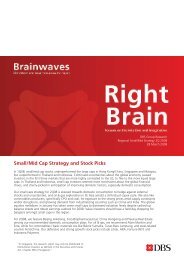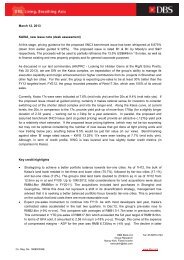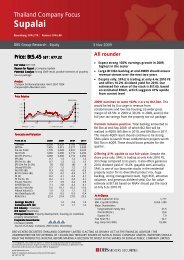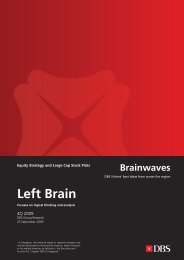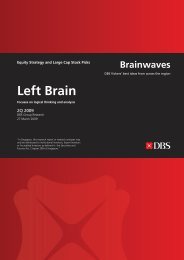Economics Markets Strategy - the DBS Vickers Securities Equities ...
Economics Markets Strategy - the DBS Vickers Securities Equities ...
Economics Markets Strategy - the DBS Vickers Securities Equities ...
Create successful ePaper yourself
Turn your PDF publications into a flip-book with our unique Google optimized e-Paper software.
<strong>Economics</strong>: Indonesia<br />
<strong>Economics</strong> – <strong>Markets</strong> – <strong>Strategy</strong><br />
we see no harm in BI tightening in larger doses of 50bps. However, owing ei<strong>the</strong>r<br />
to caution over <strong>the</strong> growth outlook and/or a desire to avoid appearing that it is<br />
in a panic over inflation, <strong>the</strong> central bank will likely continue moving in 25bp<br />
steps, unless <strong>the</strong>re is a significant decline in <strong>the</strong> rupiah or inflation starts to<br />
surprise far beyond expectations.<br />
Consumer <strong>the</strong> first victim<br />
Higher fuel prices, higher inflation and higher borrowing rates will take <strong>the</strong><br />
most immediate toll on consumer spending. Private consumption expenditure<br />
(PCE) growth this year should still match last year’s 5.0% pace, but this will owe<br />
largely to above-5% growth in <strong>the</strong> first half. In 2H08, PCE growth will probably<br />
average 4.5% YoY. Prior to <strong>the</strong> fuel price hike, rising inflation had already eaten<br />
noticeably into consumer confidence, which as of Apr08 is at two-year lows<br />
(Chart 6). Higher fuel prices and higher interest rates should also moderately<br />
dampen consumer demand for motor-vehicles.<br />
Chart 6: Inflation rising, c'ser confidence falling<br />
Index<br />
% YoY<br />
130<br />
0<br />
C'ser conf<br />
2<br />
120<br />
CPI YoY (RHS, inv)<br />
4<br />
110<br />
100<br />
6<br />
8<br />
10<br />
90<br />
80<br />
12<br />
14<br />
70<br />
60<br />
Latest: Apr08<br />
16<br />
18<br />
20<br />
Apr-03 Apr-04 Apr-05 Apr-06 Apr-07 Apr-08<br />
Chart 7: Food PCE due for an adjustment<br />
Raw and processed fd, wtd ave<br />
% YoY % YoY<br />
5<br />
4<br />
3<br />
2<br />
1<br />
0<br />
Food inflation (inv, RHS)<br />
Real food PCE<br />
<strong>DBS</strong>f<br />
Latest: 1Q08<br />
Mar-01 Sep-02 Mar-04 Sep-05 Mar-07 Sep-08<br />
0<br />
2<br />
4<br />
6<br />
8<br />
10<br />
12<br />
14<br />
16<br />
18<br />
20<br />
Food PCE may be<br />
due for a long<br />
downward<br />
adjustment<br />
Even food PCE – almost half total consumer spending – looks set for a slowdown.<br />
Despite <strong>the</strong> run-up in food prices since 2007, real spending on food has only<br />
accelerated. This might have been fuelled by <strong>the</strong> improvement in real wage<br />
growth last year, to 4-5% YoY by our estimate. However slower economic activity<br />
overall may mean that nominal wages won’t rise as much as last year; even if<br />
<strong>the</strong>y did, high inflation will erode much of those gains. Meanwhile <strong>the</strong> rise in<br />
food prices will probably become more pronounced in 2H08; back in 2005 <strong>the</strong>re<br />
were clearly pass-through effects between higher subsidized fuel prices and<br />
food prices (Chart 7). Indeed, if higher food prices are here to stay for <strong>the</strong><br />
medium-term (as organizations like <strong>the</strong> World Bank have concluded), <strong>the</strong>n <strong>the</strong><br />
downward adjustment in food PCE growth could drag out for longer than<br />
compared to non-food spending.<br />
Investment will slow on higher input, borrowing costs<br />
Public-private<br />
projects will keep<br />
investment growth<br />
decent<br />
In contrast to consumption, investment growth will be stronger than last year,<br />
at 11% versus 9.2%. Never<strong>the</strong>less on a quarterly basis it looks to us like investment<br />
growth may have already peaked in 1Q08. Spending on building and equipment<br />
surged 13.3% YoY in <strong>the</strong> first quarter, having accelerated at an almost uninterrupted<br />
pace since 3Q06. However, in <strong>the</strong> coming quarters private firms are likely to<br />
increasingly postpone <strong>the</strong>ir investment decisions, amid a more benign growth<br />
outlook, surging input costs and rising borrowing costs (Charts 8, 9). That said,<br />
<strong>the</strong> slowdown in investment growth is not going to be drastic (we’re still talking<br />
nearly 9% YoY by year-end), thanks in part to <strong>the</strong> continuance of public-private<br />
infrastructure projects.<br />
104



